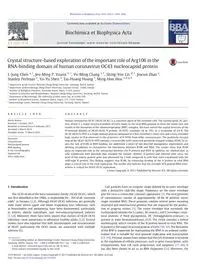
2013 Crystal structure-based exploration of the important role of Arg106 in the RNA-binding domain of human coronavirus PDF
Preview 2013 Crystal structure-based exploration of the important role of Arg106 in the RNA-binding domain of human coronavirus
Crystal structure-based exploration of the important role of Arg106 in the RNA-binding domain of human coronavirus OC43 nucleocapsid protein I.-Jung Chen a,1, Jeu-Ming P. Yuann b,1, Yu-Ming Chang c,1, Shing-Yen Lin d,1, Jincun Zhao e, Stanley Perlman e, Yo-Yu Shen a, Tai-Huang Huang f, Ming-Hon Hou a,d,g,⁎ a Department of Life Science, National Chung Hsing University, Taichung, 40254, Taiwan b Department of Biotechnology, Ming Chuan University, Taoyuan County, 33348, Taiwan c Institute of Biological Chemistry, Academia Sinica, Taipei, 11529, Taiwan d Institute of Genomics and Bioinformatics, National Chung Hsing University, Taichung, 40254, Taiwan e Department of Microbiology, The University of Iowa, Iowa City, IA 52240, USA f Institute of Biomedical Science, Academia Sinica, Taipei, 115, 11529, Taiwan g Biotechnology Center, National Chung Hsing University, Taichung, 40254, Taiwan a b s t r a c t a r t i c l e i n f o Article history: Received 1 October 2012 Received in revised form 6 February 2013 Accepted 5 March 2013 Available online 15 March 2013 Keywords: Coronaviruses Nucleocapsid protein RNA-binding X-ray crystallography Arginine106 Virus replication Human coronavirus OC43 (HCoV-OC43) is a causative agent of the common cold. The nucleocapsid (N) pro- tein, which is a major structural protein of CoVs, binds to the viral RNA genome to form the virion core and results in the formation of the ribonucleoprotein (RNP) complex. We have solved the crystal structure of the N-terminal domain of HCoV-OC43 N protein (N-NTD) (residues 58 to 195) to a resolution of 2.0 Å. The HCoV-OC43 N-NTD is a single domain protein composed of a five-stranded β-sheet core and a long extended loop, similar to that observed in the structures of N-NTDs from other coronaviruses. The positively charged loop of the HCoV-OC43 N-NTD contains a structurally well-conserved positively charged residue, R106. To as- sess the role of R106 in RNA binding, we undertook a series of site-directed mutagenesis experiments and docking simulations to characterize the interaction between R106 and RNA. The results show that R106 plays an important role in the interaction between the N protein and RNA. In addition, we showed that, in cells transfected with plasmids that encoded the mutant (R106A) N protein and infected with virus, the level of the matrix protein gene was decreased by 7-fold compared to cells that were transfected with the wild-type N protein. This finding suggests that R106, by enhancing binding of the N protein to viral RNA plays a critical role in the viral replication. The results also indicate that the strength of N protein/RNA inter- actions is critical for HCoV-OC43 replication. Crown Copyright © 2013 Published by Elsevier B.V. All rights reserved. 1. Introduction The OC43 strain of the beta coronavirus family (HCoV-OC43), which was first identified in the 1960s, is responsible for ~20% of all “common colds” in humans [1,2]. Although HCoV-OC43 infections are generally mild, more severe upper and lower respiratory tract infections, such as bronchiolitis and pneumonia, have been documented, particularly in infants, elderly individuals, and immunocompromised patients [1,3,4]. Moreover, there have been reports that clusters of HCoV-OC43 infections cause pneumonia in otherwise healthy adults [2,5]. Several studies have also reported that both neurotropism and neuroinvasion of HCoV, particularly the OC43 strain, are associated with multiple sclerosis [6]. CoV particles have an irregular shape defined by an outer envelope with a distinctive club-like shape. Peplomers on the outer envelope give the virus a crown-like (coronal) appearance [7]. The viral genomes of coronaviruses consist of approximately 30 kb of positive sense, single-stranded RNA. These genomes contain several genes encoding structural and nonstructural proteins that are required for the produc- tion of progeny virions [1]. The virion envelope that surrounds the nucleocapsid contains the S (spike), M (matrix), and E (envelope) struc- tural proteins. A third glycoprotein, HE (hemagglutinin-esterase), is present in most betacoronaviruses [8,9]. The virion contains a helical nucleocapsid, which consists of the N protein bound to viral RNA. The N protein is the major structural protein of CoVs [10–12]. The formation of the RNP is important for maintaining the RNA in an ordered confor- mation that is suitable for viral genome replication and transcription [13–16]. Previous studies have shown that the CoV N protein is involved in the regulation of cellular processes, such as gene transcription, actin reorganization, host cell cycle progression, and apoptosis [17–20]. It has also been shown to act as an RNA chaperone [21]. Moreover, the Biochimica et Biophysica Acta 1834 (2013) 1054–1062 ⁎ Corresponding author at: Biotechnology Center, National Chung Hsing University, Taichung, 40254, Taiwan. Tel.: +886 4 22840338x7011; fax: +886 4 22859329. E-mail address:
